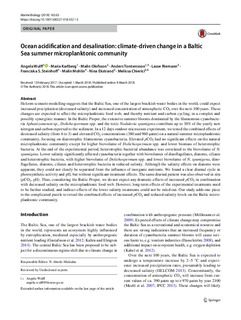| dc.description.abstract | Helcom scenario modelling suggests that the Baltic Sea, one of the largest brackish-water bodies in the world, could expect increased precipitation (decreased salinity) and increased concentration of atmospheric CO2 over the next 100 years. These changes are expected to affect the microplanktonic food web, and thereby nutrient and carbon cycling, in a complex and possibly synergistic manner. In the Baltic Proper, the extensive summer blooms dominated by the filamentous cyanobacteria Aphanizomenon sp., Dolichospermum spp. and the toxic Nodularia spumigena contribute up to 30% of the yearly new nitrogen and carbon exported to the sediment. In a 12 days outdoor microcosm experiment, we tested the combined effects of decreased salinity (from 6 to 3) and elevated CO2 concentrations (380 and 960 µatm) on a natural summer microplanktonic community, focusing on diazotrophic filamentous cyanobacteria. Elevated pCO2 had no significant effects on the natural microplanktonic community except for higher biovolume of Dolichospermum spp. and lower biomass of heterotrophic bacteria. At the end of the experimental period, heterotrophic bacterial abundance was correlated to the biovolume of N. spumigena. Lower salinity significantly affected cyanobacteria together with biovolumes of dinoflagellates, diatoms, ciliates and heterotrophic bacteria, with higher biovolume of Dolichospermum spp. and lower biovolume of N. spumigena, dinoflagellates, diatoms, ciliates and heterotrophic bacteria in reduced salinity. Although the salinity effects on diatoms were apparent, they could not clearly be separated from the influence of inorganic nutrients. We found a clear diurnal cycle in photosynthetic activity and pH, but without significant treatment effects. The same diurnal pattern was also observed in situ (pCO2, pH). Thus, considering the Baltic Proper, we do not expect any dramatic effects of increased pCO2 in combination with decreased salinity on the microplanktonic food web. However, long-term effects of the experimental treatments need to be further studied, and indirect effects of the lower salinity treatments could not be ruled out. Our study adds one piece to the complicated puzzle to reveal the combined effects of increased pCO2 and reduced salinity levels on the Baltic microplanktonic community. | nb_NO |
